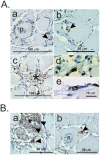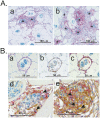Acquired Protective Immunity in Atlantic Salmon Salmo salar against the Myxozoan Kudoa thyrsites Involves Induction of MHIIβ+ CD83+ Antigen-Presenting Cells
- PMID: 28993459
- PMCID: PMC5736826
- DOI: 10.1128/IAI.00556-17
Acquired Protective Immunity in Atlantic Salmon Salmo salar against the Myxozoan Kudoa thyrsites Involves Induction of MHIIβ+ CD83+ Antigen-Presenting Cells
Abstract
The histozoic myxozoan parasite Kudoa thyrsites causes postmortem myoliquefaction and is responsible for economic losses to salmon aquaculture in the Pacific Northwest. Despite its importance, little is known about the host-parasite relationship, including the host response to infection. The present work sought to characterize the immune response in Atlantic salmon during infection, recovery, and reexposure to K. thyrsites After exposure to infective seawater, infected and uninfected smolts were sampled three times over 4,275 degree-days. Histological analysis revealed infection severity decreased over time in exposed fish, while in controls there was no evidence of infection. Following a secondary exposure of all fish, severity of infection in the controls was similar to that measured in exposed fish at the first sampling time but was significantly reduced in reexposed fish, suggesting the acquisition of protective immunity. Using immunohistochemistry, we detected a population of MHIIβ+ cells in infected muscle that followed a pattern of abundance concordant with parasite prevalence. Infiltration of these cells into infected myocytes preceded destruction of the plasmodium and dissemination of myxospores. Dual labeling indicated a majority of these cells were CD83+/MHIIβ+ Using reverse transcription-quantitative PCR, we detected significant induction of cellular effectors, including macrophage/dendritic cells (mhii/cd83/mcsf), B cells (igm/igt), and cytotoxic T cells (cd8/nkl), in the musculature of infected fish. These data support a role for cellular effectors such as antigen-presenting cells (monocyte/macrophage and dendritic cells) along with B and T cells in the acquired protective immune response of Atlantic salmon against K. thyrsites.
Keywords: Atlantic salmon; Kudoa thyrsites; antigen presentation; cytotoxicity; gene expression; immunohistochemistry; postmortem myoliquefaction.
Copyright © 2017 American Society for Microbiology.
Figures










Similar articles
-
Host size influences prevalence and severity of Kudoa thyrsites (Cnidaria: Myxosporea) infection in Atlantic salmon Salmo salar.Dis Aquat Organ. 2019 Feb 28;133(2):99-105. doi: 10.3354/dao03335. Dis Aquat Organ. 2019. PMID: 31019134
-
Development of Kudoa thyrsites (Myxozoa: Myxosporea) in netpen-reared Atlantic salmon determined by light microscopy and a polymerase chain reaction test.Dis Aquat Organ. 1999 Sep 14;37(3):185-93. doi: 10.3354/dao037185. Dis Aquat Organ. 1999. PMID: 10546048
-
Increased prevalence and severity of Kudoa thyrsites (Cnidaria: Myxosporea) in Atlantic salmon Salmo salar exposed to deeper seawater.Dis Aquat Organ. 2022 Nov 17;152:1-7. doi: 10.3354/dao03702. Dis Aquat Organ. 2022. PMID: 36394135
-
To React or Not to React: The Dilemma of Fish Immune Systems Facing Myxozoan Infections.Front Immunol. 2021 Sep 16;12:734238. doi: 10.3389/fimmu.2021.734238. eCollection 2021. Front Immunol. 2021. PMID: 34603313 Free PMC article. Review.
-
Marine netpen farming leads to infections with some unusual parasites.Int J Parasitol. 2000 Mar;30(3):321-6. doi: 10.1016/s0020-7519(00)00018-7. Int J Parasitol. 2000. PMID: 10719125 Review.
Cited by
-
Sea lice (Lepeophtheirus salmonis) life stage impacts atlantic salmon transcriptomic responses under different thermal profiles.Front Genet. 2025 Jul 29;16:1633603. doi: 10.3389/fgene.2025.1633603. eCollection 2025. Front Genet. 2025. PMID: 40799220 Free PMC article.
-
Induction of foxp3 during the Crosstalk between Antigen Presenting Like-Cells MHCII+CD83+ and Splenocytes CD4+IgM- in Rainbow Trout.Biology (Basel). 2021 Apr 13;10(4):324. doi: 10.3390/biology10040324. Biology (Basel). 2021. PMID: 33924548 Free PMC article.
-
Better the devil you know: sympatric fish host copes better than allopatric with a myxozoan parasite.Front Cell Infect Microbiol. 2025 Jun 27;15:1576014. doi: 10.3389/fcimb.2025.1576014. eCollection 2025. Front Cell Infect Microbiol. 2025. PMID: 40654568 Free PMC article.
-
Smoltification of Atlantic Salmon (Salmo salar L.) Is Associated with Enhanced Traffic and Renewal of B Cell Repertoire.Genes (Basel). 2024 Sep 18;15(9):1220. doi: 10.3390/genes15091220. Genes (Basel). 2024. PMID: 39336811 Free PMC article.
-
Intestinal Transcriptomic and Histologic Profiling Reveals Tissue Repair Mechanisms Underlying Resistance to the Parasite Ceratonova shasta.Pathogens. 2021 Sep 13;10(9):1179. doi: 10.3390/pathogens10091179. Pathogens. 2021. PMID: 34578212 Free PMC article.
References
-
- Moran JDW, Whitaker DJ, Kent ML. 1999. A review of the myxosporean genus Kudoa Meglitsch, 1947, and its impact on the international aquaculture industry and commercial fisheries. Aquaculture 172:163–196. doi:10.1016/S0044-8486(98)00437-2. - DOI
-
- Dawson-Coates JA, Chase JC, Funk V, Booy MH, Haines LR, Falkenberg CL, Whitaker DJ, Olafson RW, Pearson TW. 2003. The relationship between flesh quality and numbers of Kudoa thyrsites plasmodia and spores in farmed Atlantic salmon, Salmo salar L. J Fish Dis 26:451–459. doi:10.1046/j.1365-2761.2003.00477.x. - DOI - PubMed
Publication types
MeSH terms
Substances
LinkOut - more resources
Full Text Sources
Other Literature Sources
Research Materials

